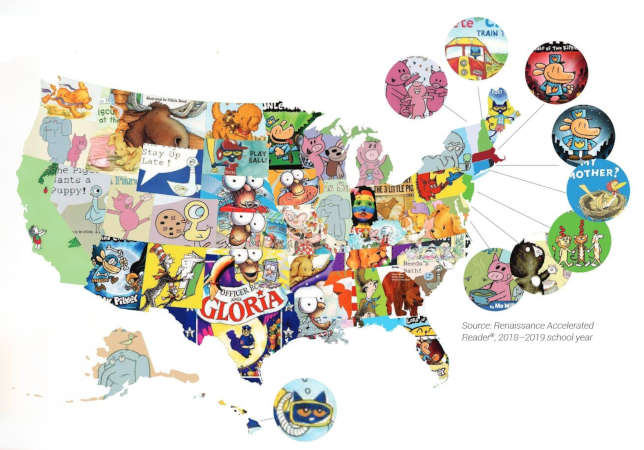Latest Reading Report Tracks Trends of Reading in K–12
- By Dian Schaffhauser
- 03/02/20
K-2
students tend to enjoy books with poetry and rhymes, putting Dr.
Seuss at or near the top of their reading lists. For grades 3-5,
sports and recreation take center stage. As students begin the move
into middle school, interpersonal relationships are big. And as
students go into high school, they continue showing interest in
sports and focus on assigned reading. Those are the broad findings of
this year's "What
Kids are Reading, 2020 Edition,"
the Renaissance
report that tabulates student reading. The latest report used data
from the 2018-2019
school year.
The
results were drawn from data generated by two services produced by
the company: Accelerated
Reader,
which tracks books and articles in both print and digital form "that
students have read from start to finish"; and myON,
which tracks student reading on a personalized digital library
platform.

The
most read books by grade level for the 2018-2019 school year were:
-
Kindergarten:
Biscuit
Series
by Alyssa Satin Capucilli
-
Grade
1: Dr.
Seuss Collection
by Dr. Seuss
-
Grade
2: Dr.
Seuss Collection
by Dr. Seuss
-
Grade
3: Dog
Man Series
by Dav Pikey
-
Grade
4: Diary
of a Wimpy Kid
Series
by Jeff Kinney
-
Grade
5: Diary
of a Wimpy Kid
Series
by Jeff Kinney
-
Grade
6: Diary
of a Wimpy Kid Series
by Jeff Kinney
-
Grade
7: Giver
Quartet
by Lois Lowrey
-
Grade
8: The
Outsiders
by S.E. Hinton
-
Grade
9: To
Kill a Mockingbird
by Harper Lee
-
Grade
10: Night
by Elie Wiesel
-
Grade
11 The
Crucible
by Arthur Miller
-
Grade
12: Hamlet
by William Shakespeare
However,
top books varied by state. While Hi!
Fly Guy was
number one in Iowa for grade 1, in Massachusetts it was Seven
Blind Mice. While
Virginia sixth graders pushed Wonder
into the top spot, for Louisiana it was Hatchet.
And more California 11th graders chose The
Great Gatsby,
while in Michigan it was Of
Mice and Men.
The
report also noted that as students move through school, they tend to
spend less time reading nonfiction, in spite of the fact that
National Assessment of Education Progress (NAEP) reading guidelines
suggest the opposite. In grades K-2 they spent about 48 percent of
their reading time on nonfiction, which jumped to 54 percent for
grades 3-5. NAEP guidelines suggest that by grade 4, about half of
reading should be nonfiction. The amount of time students in grades
6-8 spent reading nonfiction dropped to 52 percent even though NAEP
advises about 55 percent. And in high school, even though NAEP
recommends that 70 percent of reading be nonfiction, in reality
higher schoolers spent just 43 percent of their reading time on that.
The
number of topics students show interest in through their reading
practices also narrows as they age. While grade K-2 students explored
an average of 22 topics (meaning they've passed a quiz for more than
a single book on a given subject) and students in grades 3-5 explored
24, by grades 6-8, that had dropped to 15 and by grades 9-12 it was
nine topics. As the report noted, as students "read both deeply
and widely--multiple books within and across different topics--they
solidify that content knowledge while also strengthening
comprehension skills." Top nonfiction topics across all grades
were animals, science and biographies or autobiographies. In fiction,
it was animals, family life and humor.
"Providing
students with reading materials that are culturally relevant,
appealing and accessible cannot be overstated," said Gene Kerns,
vice president and chief academic officer at Renaissance, in a
statement. "What
Kids Are Reading
provides a unique glimpse into what other students are reading and
hopefully sparks new discoveries for others."
The
report is available with registration on
the Renaissance website.
Educators can also create a custom report of the findings by entering
state, grade and difficulty level on the same webpage. The company
said it would be hosting a webinar
to discuss the latest findings
on Mar. 18, 2020 at 3 p.m. Eastern time.
About the Author
Dian Schaffhauser is a former senior contributing editor for 1105 Media's education publications THE Journal, Campus Technology and Spaces4Learning.